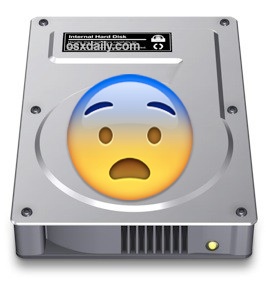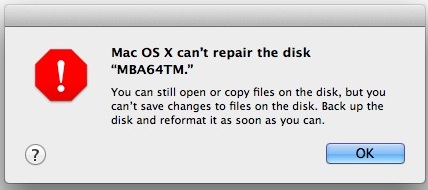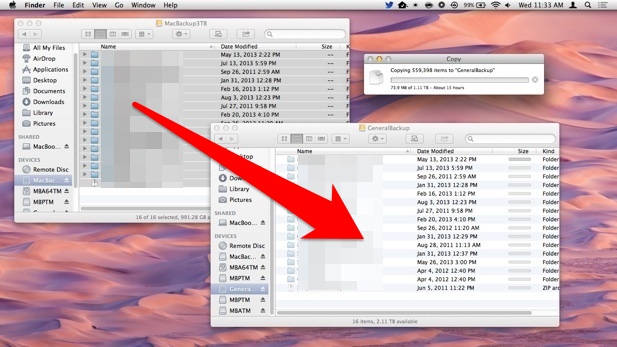Recover Files & Data from a Failing Hard Drive in Mac OS X the Simple Way
 Hard drive failures are never fun but they are a fact of computing life whether you use a Mac or PC. Sometimes drives can truck along for many years before going bad, and other times you wind up with a drive that goes kaput after just a few months of normal use. Regardless of when it happens (and it will), we’re going to focus on the most simple method of retrieving crucial files and data from the failing drive.
Hard drive failures are never fun but they are a fact of computing life whether you use a Mac or PC. Sometimes drives can truck along for many years before going bad, and other times you wind up with a drive that goes kaput after just a few months of normal use. Regardless of when it happens (and it will), we’re going to focus on the most simple method of retrieving crucial files and data from the failing drive.
At it’s simplest form, you’re essentially performing a standard file transfer, but with time working against you it’s important to move fast and to not make anything worse, thus a simple multiple-step plan of action is recommended for the best results. This isn’t perfect and it’s by no means guaranteed, but if caught in the early stages of failure you can almost certainly get your data off the drive before it’s too late. The focus here is on secondary hard drives; meaning backups, external disks, time machine drives, etc, and because your backups can fail, it’s a good example of why redundant backups are important for some users. Thankfully, backup redundancy is extremely easy to do with Time Machine and only requires two external drives to be connected to the Mac at a time.
The basic method offered below can work for a boot drive as well, but you would want to boot the Mac from a separate USB boot disk for best results.
Identifying a Drive Failure Problem
Impending hard drive failures can be identified in a number of ways. In the worst situations you’ll sometimes you’ll hear abnormal sounds coming from a drive, but typically you will get software-side warnings first. Failing drives may randomly eject themselves, and OS X can provide some obvious signals of when a drive isn’t functioning properly too; sometimes connecting a drive may forcibly mount in “Read Only” mode, sometimes Disk Utility won’t be able to verify or repair the disk, and sometimes you’ll be told to backup and reformat the drive in question.

Whether or not formatting the disk is going to matter in the long run depends on the type of drive failure, a ‘logical failure’ is typically the result of file system corruption and reformatting a disk will typically make it work again, whereas a ‘mechanical failure’ means physical components of the drive are damaged.
1: Power Off the Failing Drive & Eject
Keep the failing drive powered off, ejected from the Mac, and not connected to anything until you are ready to perform the all important file transfer. You do not want to put any additional burden or stress on the failing drive by using it more than it needs to be used. At this point you should think in a data preservation and recovery mindset, so it’s best to leave the drive powered off until you are ready to copy files over to the new replacement drive.
2: Get a New Hard Drive & Format / Partition
Buy a new replacement drive as soon as possible. These are plentiful and cheap on Amazon![]() nowadays and you can get huge amounts of storage for great prices. Once you have your drive:
nowadays and you can get huge amounts of storage for great prices. Once you have your drive:
- Format the drive to be Mac compatible, this is easy and we’ve shown how to do it before
- If your previous drive was partitioned, do the same with the new drive
Because time is important when drives are going bad, get everything ready on the replacement drive before attempting to copy files from the old failing drive to the new working one. Again, keep the old drive powered off until you are ready to perform a file transfer.
3: Connect the Failing Drive and Start File Transfers
Once the new replacement drive is ready to go, keep it connected to the Mac. Now comes the time to power up the failing drive, so connect it to the Mac, and start to copy over your files from the failing drive to its new replacement.
Going the simplest route, what I like to do is just open a Finder window with both the old drive and the new drive, select all from the old drive, then do a normal old drag & drop to start an enormous file transfer.

The transfer process can take a very long time so be prepared to wait. You’ll probably want to just let the copy process start and then go about your day or night since waiting around for hours is never fun. Don’t be surprised if it takes 12 hours for each 1TB of data transfer, thus copying overnight can be the best way to go.
If the failing drive was an automated backup, the process for moving Time Machine backups is similar.
Important: If Time Machine backups are on, temporarily turn them off to prevent writing to the failing drive while you are trying to copy files from it. This can be done through the System Preferences for Time Machine, accessible via the Apple menu.
Help! File Copying from the Drive is Failing!
If copying of data is failing at any point, or a disk continues to unmount itself randomly, you can try copying over smaller amounts of files at a time, though you will likely continue to run into issues. When standard file transfers fail, you may need to go with a third party app like DiskWarrior or Disk Drill, both of which cost about $100 and are great utilities that can recover data from failing drives when the traditional transfer methods fail.
File security measures like FileVault encryption and Time Machine encryption can complicate the data recovery process, but because turning those features off causes a lot of disk writing it’s usually best to leave them on while you perform the manual backups.
If all else fails, the final option would be to go with a professional data recovery service. Such services are never cheap, but if you have precious data to retrieve it may be worth the expense.


This article did a great job discussing the disaster recovery plan of most businesses.
First and foremost, stop using the drive for anything. Otherwise, you will begin overwriting information you are trying to recover.
To attempt this yourself, you first need to put the drive back the way it was so it will show up in recovery software. Both options below require the drive to be formatted as a Mac partition.
1) Go back to Disk Utility and make the drive a single partition as OS X Extended, which is where it was to begin with. DO NOT choose any options such as a zero write erase. Only the quick repartitioning. That will rewrite just the file table and leave the rest of the drive alone.
2) Purchase either uFlysoft or FileSalvage. DO NOT download them to, or install them on the drive you are trying to recover.
3) If you have no other drive to install the recovery software to, you can purchase them on a bootable disk. But that still leaves you needing a second drive to recover your files to. You cannot recover files to the same drive you are working from, as it will overwrite files at the same time it is trying to recover them. So you will also have to purchase another drive. Internal, or external, and format it for Mac OS Extended.
If after that, you still can’t recover what you need, your only option is a recovery service, such as Drive Savers. This can easily run over a thousand dollars.
I received the same message as the one above (Mac OS Can’t repair the disk.. you can still open…) since my mac cant repair disk/ boot itself.. i installed OSX onto an external hard drive and am currently running my mac through that. I can see my damaged hard drive and when I click on it, it takes a long time until my files show up.. they seem to be loading (unless it freezes which then I have to restart finder and start all over again) but its taking a long time… ive waited about an hour to see my files in “Desktop folder” and they still dont show up.. due to my impatient I went to another folder in efforts to salvage those…which still takes about 15 minutes to finally see the files… and then theres subfiles in that folder… this process will take forever. i tried to clone drive via disk utility but during the process.. i always get an error message that interrupts the process (input/output error.. cant remember the other errors i get) anyways.. why is it taking so long for files to open? could it be that the usb cable i have is very slow? if so should i buy a faster usb cable? does it have to do anything with the usb cable? if i buy an online program to help me recover files.. will that help in that files will show up instantaneously without me having to wait? PLEASE HELP!!
Hi,
My MBP is a (late 2006) with mac os x (10.8) upgraded from snow leopard.
it has wndows xp installed in the BOOTCAMP partition. my mac is booting only in the windows partition. it is not booting up in the main partition or the recovery partition. It does’nt boot up in the safe mode too. it continues to reboot cycle. it boots into single user mode.
I used the fsck – fy command till it says that the volume is ok. i then use exit to reboot. but it does not boot in any partition main or the recovery partition.
Friends is there a way to get my data off the drive using the terminal? I have my pictures and videos over these years on this drive.
Once the data is off the drive how to get the installer from appstore from the terminal?
I am perplexed really?
My apple store in India says they dont service vintage macs.
I am relying on the web.
I have been looking for software which can help me to recover files from my
crashed Mac system. This search ended on this webpage… thank u admin..
other tool that I found was Remo recover, which was quite promising.
After using this tool, I have recovered most of the data but some of them are still undiscovered. Then, I got an efficient application named Remo Recover that restored entire data from the failed hard drive very easily.
Your software is good to recover files from failing hard drive but recently I am working on Mac10.5 OS X so can I use your utility?